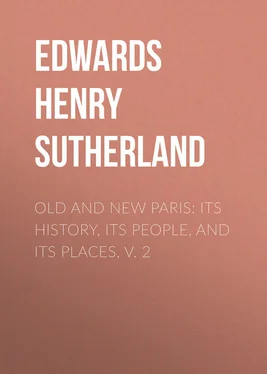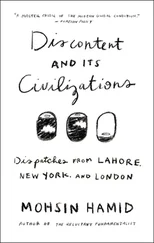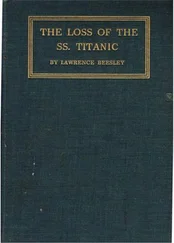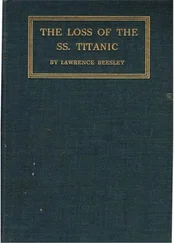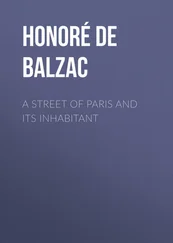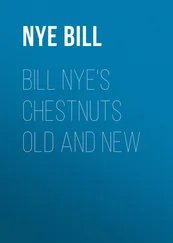Henry Edwards - Old and New Paris - Its History, Its People, and Its Places, v. 2
Здесь есть возможность читать онлайн «Henry Edwards - Old and New Paris - Its History, Its People, and Its Places, v. 2» — ознакомительный отрывок электронной книги совершенно бесплатно, а после прочтения отрывка купить полную версию. В некоторых случаях можно слушать аудио, скачать через торрент в формате fb2 и присутствует краткое содержание. Жанр: foreign_antique, foreign_prose, Путешествия и география, на английском языке. Описание произведения, (предисловие) а так же отзывы посетителей доступны на портале библиотеки ЛибКат.
- Название:Old and New Paris: Its History, Its People, and Its Places, v. 2
- Автор:
- Жанр:
- Год:неизвестен
- ISBN:нет данных
- Рейтинг книги:4 / 5. Голосов: 1
-
Избранное:Добавить в избранное
- Отзывы:
-
Ваша оценка:
- 80
- 1
- 2
- 3
- 4
- 5
Old and New Paris: Its History, Its People, and Its Places, v. 2: краткое содержание, описание и аннотация
Предлагаем к чтению аннотацию, описание, краткое содержание или предисловие (зависит от того, что написал сам автор книги «Old and New Paris: Its History, Its People, and Its Places, v. 2»). Если вы не нашли необходимую информацию о книге — напишите в комментариях, мы постараемся отыскать её.
Old and New Paris: Its History, Its People, and Its Places, v. 2 — читать онлайн ознакомительный отрывок
Ниже представлен текст книги, разбитый по страницам. Система сохранения места последней прочитанной страницы, позволяет с удобством читать онлайн бесплатно книгу «Old and New Paris: Its History, Its People, and Its Places, v. 2», без необходимости каждый раз заново искать на чём Вы остановились. Поставьте закладку, и сможете в любой момент перейти на страницу, на которой закончили чтение.
Интервал:
Закладка:
If, however, the public lamps of Paris are the most conspicuous street objects by night, those which first strike the eye by day are unquestionably the vehicles.
In France, as in other countries, carriages are comparatively of modern invention; and when they were first introduced they were generally condemned as calculated to do away with a taste for equitation and to produce habits of effeminacy. The condition of the streets and public thoroughfares would, in ancient times, have rendered the employment of vehicles impossible, and thus persons who did not go on foot went on horseback until the sixteenth century, when the use of the so-called “Sedan-chairs” became general. Wheeled carriages were not absolutely unknown, but in Francis I.’s reign there were but two, one belonging to the king, the other to the queen. The privilege of constructing and letting out Sedan-chairs, or “chaises à bras,” was granted by Louis XIII. at the beginning of the seventeenth century to one of the officers of his body-guard; and towards the end of the reign, after many other inventions in the way of vehicles had been tried, two-wheeled chaises, called “brouettes,” or “wheelbarrows,” were introduced by a Monsieur Dupin, who received the king’s support in the shape of a formal authorisation. There was now a great dispute between the privileged makers of Sedan-chairs and the privileged makers of “wheelbarrows,” which ended in this compromise – that the new wheelbarrows were not to be allowed unless drawn exclusively by men. In the reign of Henry IV. the carriage, or “carrosse,” was introduced: a heavy, lumbering vehicle, whose windows were hung with leather curtains. The use of glass in carriage windows had not yet been adopted. Henry IV. was himself driving in one of these carriages when Ravaillac thrust his hand through the window and struck the fatal blow.
The first coach with glass windows – “glass-coach,” as the new vehicle was called when, many years later, it was introduced into England – was seen in Paris in 1630, brought there from Brussels by the Prince de Condé. Up to the middle of the seventeenth century no wheeled vehicles were seen in the streets of Paris except those belonging to private persons. In 1650, however, it occurred to a man named Sauvage, living in an hotel in the Rue Saint-Martin, which bore the sign of “Saint-Fiacre,” to let out horses and carriages to anyone who wanted them; and in time the name of fiacre was given to all hired carriages. Soon afterwards, about the middle of the seventeenth century, so-called “diligences” were established for conveying “with diligence” passengers in common from one part of France to another; and from the idea of conveying a number of passengers in the same vehicle from town to town was derived that of the omnibus, doing a like service within the walls of the capital. The invention of the omnibus is attributed to Pascal, the author of so many “Pensées” of a finer type. The original Parisian omnibus was called the “five sous carriage” – “carrosse au cinq sous” – five sous being required from each passenger. It held six persons, and carried as a distinctive sign a lantern at the end of an iron pole, which was fixed on the top, to the left of the driver.
Until the time of the Revolution the right of letting out carriages was always made the subject of a privilege or concession, accorded to some court favourite, male or female. After the Revolution, however, when all privileges were abolished, those connected with the letting out of public vehicles came to an end. A few years afterwards, in 1800, a tariff regulating the prices payable to the drivers of hackney carriages was drawn up, when, as now, the cost of a drive, or “course,” inside Paris, was fixed at something above a franc, two francs being chargeable per hour if the vehicle were hired by time. Originally private carriages had now become public, so that at last a demand arose for carriages which might be taken by the month, the week, the day, or the half-day.
Hitherto all the hackney vehicles of Paris had been of one pattern and furnished with four wheels. They seated either two or four passengers, and were drawn by one or two horses. In the year 1800 the two-wheeled “cabriolet” was introduced, containing seats for two, one of which was occupied by the driver, to whose intimate society the unfortunate passenger was thus condemned. From this period until 1830 the public vehicles of Paris were, according to a French writer, “a disgrace to the capital.” They were drawn by ruined beasts which looked unlikely to reach any given destination, and they were many of them good for nothing but firewood.
The Paris hackney vehicle largely excited at this time the ridicule of wits and song-writers, although, irrespectively of its condition, it has always figured almost exclusively in literature. In a great city like Paris the cab is the witness, the auxiliary, or the accomplice in nearly every event which takes place – it is a mute confidant in most of the scenes of human life. The song-writer, Desaugiers, has left in verse a curious history of a cab, supposed to be written by itself, and in which it relates how one day it conveyed a widow to the altar, another day a husband to Chantilly without his wife, and a third day the wife to Gros-Bois without her husband.
Coming to modern times, we find the driver of the fiacre as interesting a personage as he must frequently find his fare to be. The question whether, as is asserted, ruined aristocrats are at present earning their bread as cab-drivers has already been discussed. But it is unquestionable that many members of what are called the “better” classes turn to the cab as their last resource, even as Dr. Johnson’s “scoundrel” was said to turn to politics. Priests, devoid in two senses of a living, bachelors of arts and sciences, old professors and worn-out notaries, may be seen plying the whip of the “cocher” in the Paris streets.
That the London cab – of which the name, as probably everyone knows, is simply a contraction of “cabriolet” – surpasses the cab of Paris is admitted even by patriotic Frenchmen. One able writer on the subject of the French capital says that “the London cabs, which we have vainly tried to acclimatise in Paris, are, if not comfortable, at least rapid and well-managed. Our neighbours can boast two elements of incontestable superiority. These are the drivers and the horses. Despite these causes, it is probable that the English ‘cab’ would be found less attractive if, instead of being paid by the mile, it were taken by the journey or by the hour.” This writer, it should be explained, complains bitterly that the Parisian cabman, engaged by the hour, proceeds at a crawl, knowing that he will be paid just as much as if he drove with the celerity of his London brother, who simply wants to get to his journey’s end and receive his fare – or as much beyond it as he possibly can.
As regards the omnibuses of Paris, they resemble in many respects those of London. For instance, they are painted different colours according to their particular route. When the vehicle is quite full a board or card announcing the fact is fixed up over the door; and each vehicle is numbered so that in case of complaint it can be identified by the passenger.
The private carriages let out on hire – those which can be taken by the month or for the season – are not permitted to ply in the streets of Paris like the fiacre. They take up their passenger at his own door, and can be hired by the year, month, day, or half-day. The form of these vehicles varies, according to the caprices or the fortune of the hirer, from plain to magnificent. In France, as in England, rich families accustomed to winter in the capital leave their own carriages in the country and hire others by the month. Even wealthy Frenchmen, who reside altogether in the capital, have of late years shown themselves more and more disposed to escape in this way the trouble and annoyance connected with the maintenance of personal equipages. Nor do those Englishmen who have tried both methods feel a less marked preference for that of hire, which relieves them from the numerous anxieties associated with the stable. It will be remembered how Henry J. Byron’s coachman came to that comedy-writer one day and said that the mare was ill. “What’s to be done?” asked Byron. “I shall have to give her a ball, sir,” was the reply. “Very well,” said Byron with a sigh of resignation, “but don’t ask too many people.”
Читать дальшеИнтервал:
Закладка:
Похожие книги на «Old and New Paris: Its History, Its People, and Its Places, v. 2»
Представляем Вашему вниманию похожие книги на «Old and New Paris: Its History, Its People, and Its Places, v. 2» списком для выбора. Мы отобрали схожую по названию и смыслу литературу в надежде предоставить читателям больше вариантов отыскать новые, интересные, ещё непрочитанные произведения.
Обсуждение, отзывы о книге «Old and New Paris: Its History, Its People, and Its Places, v. 2» и просто собственные мнения читателей. Оставьте ваши комментарии, напишите, что Вы думаете о произведении, его смысле или главных героях. Укажите что конкретно понравилось, а что нет, и почему Вы так считаете.
